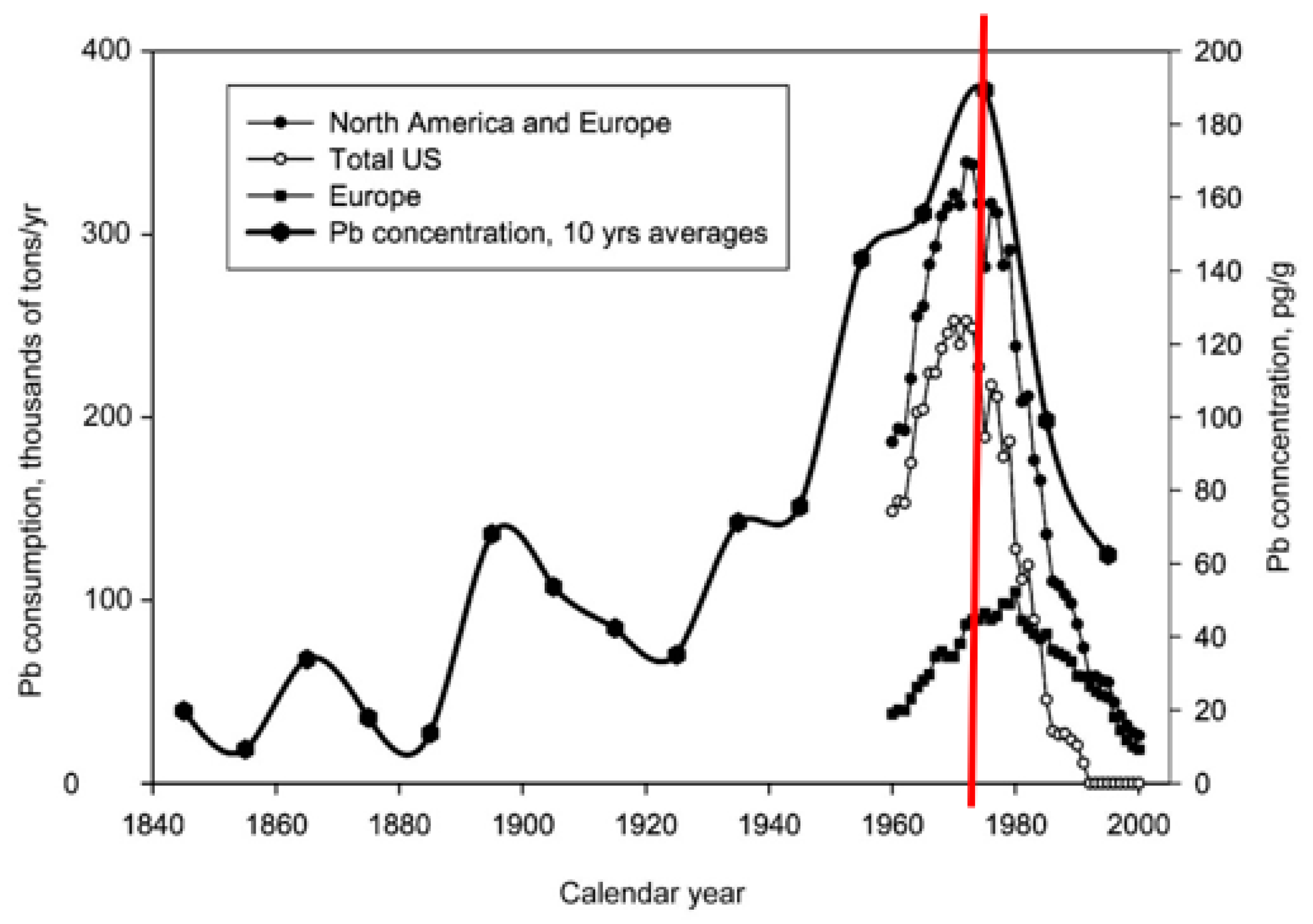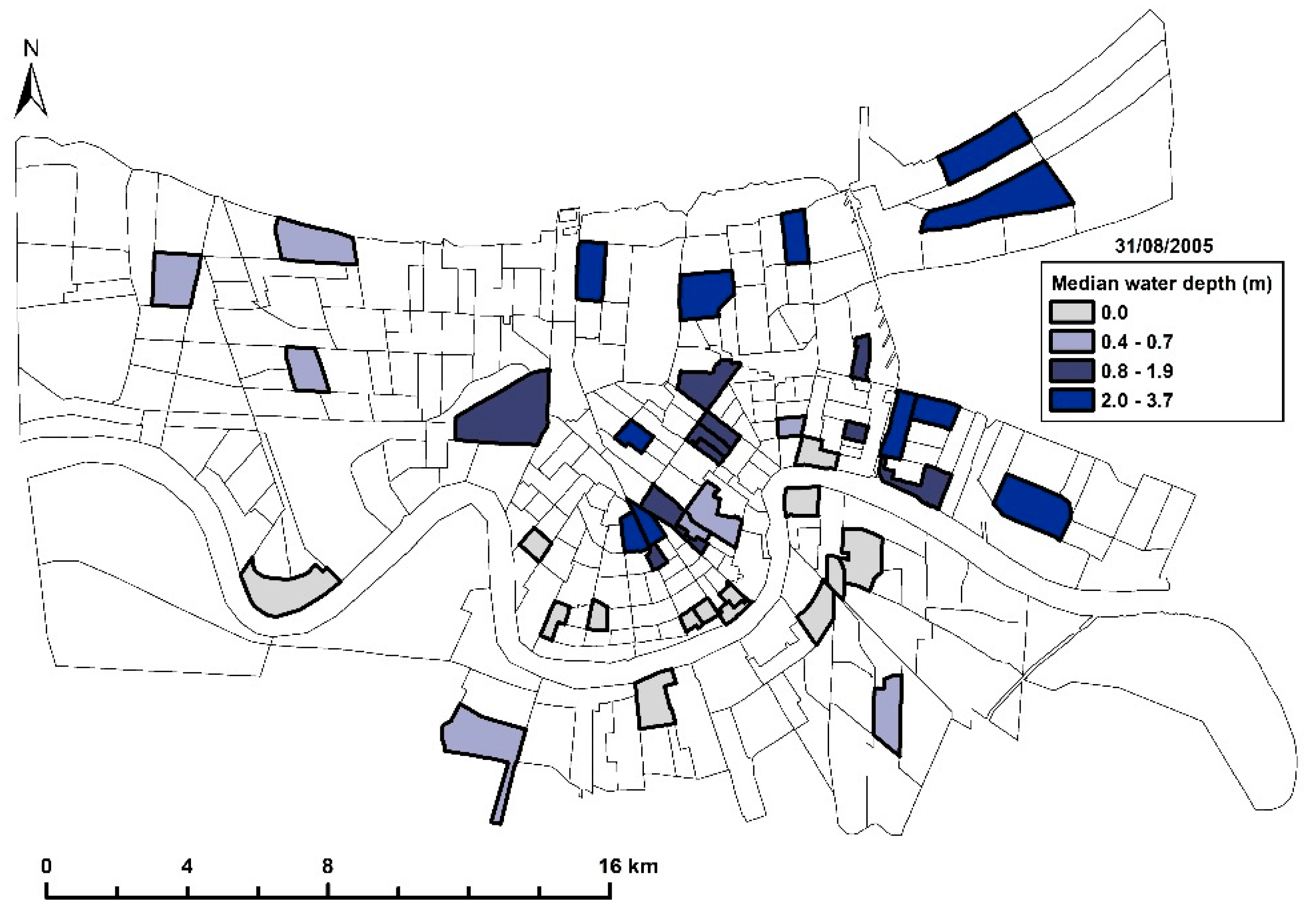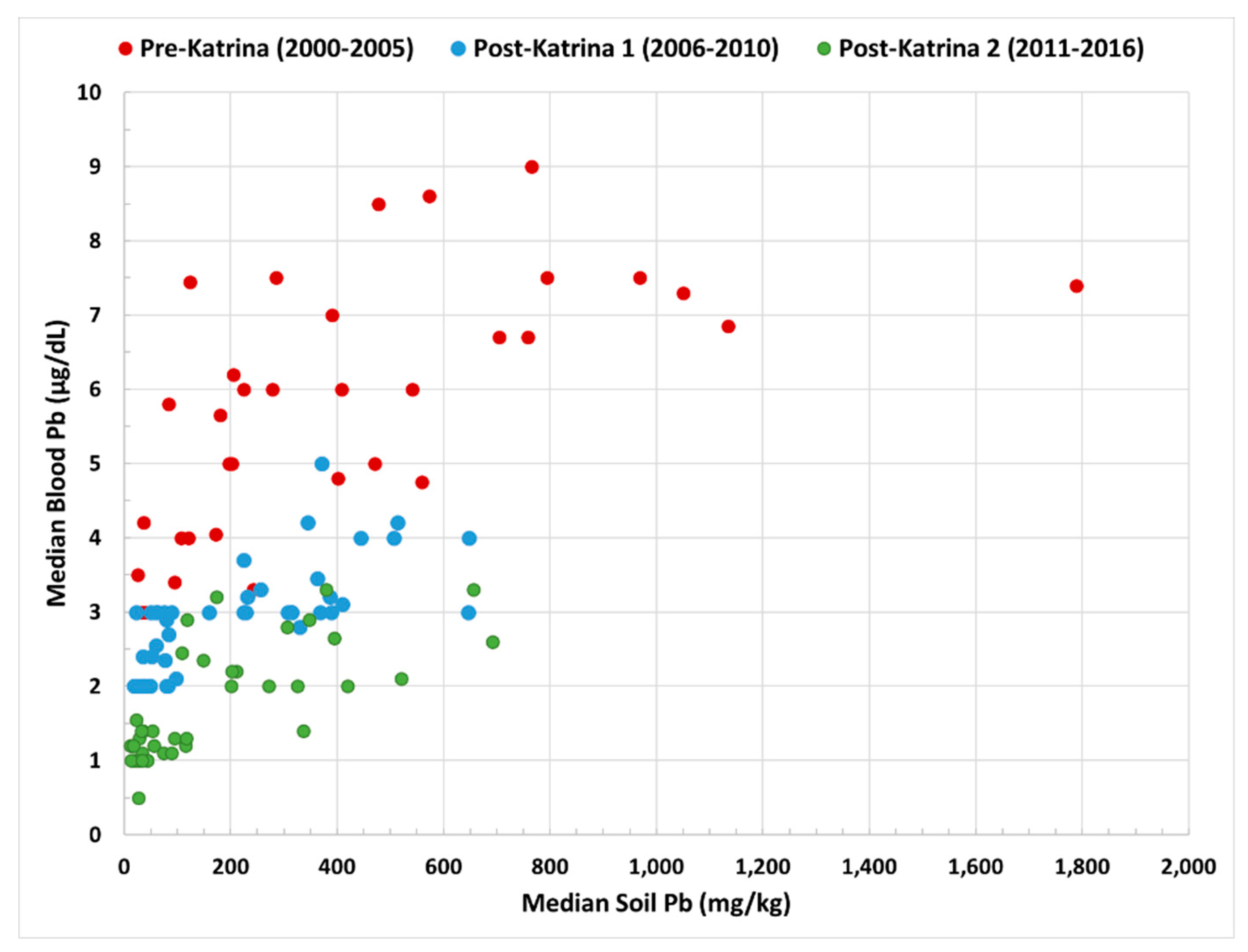Curtailing Lead Aerosols: Effects of Primary Prevention on Declining Soil Lead and Children’s Blood Lead in Metropolitan New Orleans
Abstract
1. Introduction
2. Methods
2.1. Soil Collection
2.2. Soil Pb Extraction and Analysis
2.3. Soil Analysis Quality Assurance Quality Control (QAQC)
2.4. Children’s Blood-lead Data
2.5. Statistical Analysis
3. Results and Discussion
Temporal Decreases in SPb and BPb during Three Surveys of 44 Communities
4. Continuing Exposure and Primary Lead Prevention for Children
5. Conclusions
Author Contributions
Funding
Acknowledgments
Conflicts of Interest
References
- World Health Organization. Global Health Observatory. Urban Population Growth. Available online: http://www.who.int/gho/urban_health/situation_trends/urban_population_growth_text/en/ (accessed on 10 June 2019).
- Bai, X. Advance the ecosystem approach in cities. Nature 2018, 559, 7. [Google Scholar] [CrossRef] [PubMed]
- Reuben, A. Childhood lead exposure and adult neurodegenerative disease. J. Alzheimer’s Dis. 2018, 64, 17–42. [Google Scholar] [CrossRef] [PubMed]
- Sanders, T.; Liu, Y.; Buchner, V.; Tchounwou, P.B. Neurotoxic Effects and Biomarkers of Lead Exposure: A Review. Rev. Environ. Health 2009, 24, 15–45. [Google Scholar] [CrossRef] [PubMed]
- Landrigan, P.J.; Fuller, R.; Acosta, N.J.; Adeyi, O.; Arnold, R.; Baldé, A.B.; Bertollini, R.; Bose-O’Reilly, S.; Boufford, J.; Breysse, P.N.; et al. The Lancet Commission on pollution and health. Lancet 2018, 391, 462–512. [Google Scholar] [CrossRef]
- Lanphear, B.P.; Rauch, S.; Auinger, P.; Allen, R.W.; Hornung, R.W. Low-level lead exposure and mortality in US adults: A population-based cohort study. Lancet Public Health 2018, 3, 177–184. [Google Scholar] [CrossRef]
- Schraufnagel, D.E.; Balmes, J.R.; Cowl, C.T.; De Matteis, S.; Jung, S.H.; Mortimer, K.; Perez-Padilla, R.; Rice, M.B.; Riojas-Rodriguez, H.; Sood, A.; et al. Air Pollution and Noncommunicable Diseases: A Review by the Forum of International Respiratory Societies’ Environmental Committee, Part 1: The Damaging Effects of Air Pollution. Chest 2019, 155, 409–416. [Google Scholar] [CrossRef] [PubMed]
- Zahran, S.; Laidlaw, M.A.S.; Rowe, D.B.; Ball, A.S.; Mielke, H.W. Motor neuron disease mortality and lifetime petrol lead exposure: Evidence from national age-specific and state-level age-standardized death rates in Australia. Environ. Res. 2017, 153, 181–190. [Google Scholar] [CrossRef] [PubMed]
- Patterson, C.C. Lead in the Human Environment; Alternative Perspective; National Academy of Sciences: Washington, DC, USA, 1980; p. 271. [Google Scholar]
- Mielke, H.W.; Anderson, J.C.; Berry, K.J.; Mielke, P.W., Jr.; Chaney, R.L. Lead concentrations in inner city soils as a factor in the child lead problem. Am. J. Public Health 1983, 73, 1366–1369. [Google Scholar] [CrossRef] [PubMed]
- Mielke, H.W.; Adams, J.L.; Reagan, P.L.; Mielke, P.W., Jr. Soil-dust lead and childhood lead exposure as a function of city size and community traffic flow: The case for lead abatement in Minnesota. Environ. Geochem. Health 1989, 9, 253–271. [Google Scholar]
- Treasury Department, United States Public Health Service. Proceedings of a Conference to Determine Whether or Not There Is a Public Health Question in the Manufacture, Distribution, or Use of Tetraethyl Lead Gasoline; Public Health Bulletin No. 158 (August 1925); Government Printing Office: Washington, DC, USA, 1925.
- Krachler, M.; Zheng, J.; Fisher, D.; Shotyk, W. Direct Determination of Lead Isotopes (206Pb, 207Pb, 208Pb) in Arctic Ice Samples at Picogram per Gram Levels Using Inductively Coupled Plasma-Sector Field MS Coupled with a High-Efficiency Sample Introduction System. Anal. Chem. 2004, 76, 5510–5517. [Google Scholar] [CrossRef] [PubMed]
- Mielke, H.W.; Laidlaw, M.A.S.; Gonzales, C. Characterization of lead (Pb) from traffic in 90 U.S.A. urbanized areas: Review of urban lead dust and health. Environ. Int. 2011, 37, 248–257. [Google Scholar] [CrossRef] [PubMed]
- Kovarik, W. Ethyl-leaded gasoline: How a classic occupational disease became an international public health disaster. Int. J. Occup. Environ. Health 2005, 11, 384–397. [Google Scholar] [CrossRef] [PubMed]
- Huang, S.; Lawrence, J.; Kang, C.M.; Li, J.; Martins, M.; Vokonas, P.; Gold, D.R.; Schwartz, J.; Coull, B.A.; Koutrakis, P. Road proximity influences indoor exposures to ambient fine particle mass and components. Environ. Pollut. 2018, 243, 978–987. [Google Scholar] [CrossRef] [PubMed]
- O’Connor, J.T. The automobile controversy-federal control of vehicular emissions. Ecol. Law Q. 1975, 4, 661–691. [Google Scholar]
- Kessler, R. Sunset for leaded aviation Gasoline? Environ. Health Perspect. 2013, 121, A55–A57. [Google Scholar] [CrossRef] [PubMed][Green Version]
- U.S. EPA (Environmental Protection Agency). National Emissions Inventory Data and Documentation [website]. Research Triangle Park, NC: Office of Air Quality Planning & Standards, U.S. Environmental Protection Agency (updated 28 August 2012). 2008. Available online: https://www.epa.gov/air-emissions-inventories (accessed on 26 September 2018).
- Miranda, M.L.; Anthopolos, R.; Hastings, D. A geospatial analysis of the effects of aviation gasoline on childhood blood lead levels. Environ. Health Perspect. 2011, 119, 1513–1516. [Google Scholar] [CrossRef] [PubMed]
- Paulson, J.A.; Brown, M.J. The CDC blood lead reference value for children: Time for a change. Environ. Health 2019, 18, 16. [Google Scholar] [CrossRef] [PubMed]
- Nussbaumer-Streit, B.; Yeoh, B.; Griebler, U.; Pfadenhauer, L.M.; Busert, L.K.; Lhachimi, S.K.; Lohner, S.; Gartlehner, G. Household interventions for preventing domestic lead exposure in children (Review). The Cochrane Library. Available online: https://www.cochranelibrary.com/cdsr/doi/10.1002/14651858.CD006047.pub5/media/CDSR/CD006047/CD006047.pdf (accessed on 10 June 2019).
- Mielke, H.W.; Gonzales, C.; Powell, E.; Mielke, P.W., Jr. Changes of Multiple Metal Accumulation (MMA) in New Orleans Soil: Preliminary Evaluation of Differences between Survey I (1992) and Survey II (2000). Int. J. Environ. Res. Public Health 2005, 2, 308–313. [Google Scholar] [CrossRef] [PubMed]
- Zahran, S.; Mielke, H.W.; Gonzales, C.R.; Powell, E.T.; Weiler, S. New Orleans Before and After Hurricanes Katrina/Rita: A Quasi-Experiment of the Association between Soil Lead and Children’s Blood Lead. Environ. Sci. Technol. 2010, 44, 4433–4440. [Google Scholar] [CrossRef] [PubMed]
- Mielke, H.W.; Gonzales, C.R.; Powell, E.T.; Mielke, P.W., Jr. Spatiotemporal dynamic transformations of soil lead and children’s blood lead ten years after Hurricane Katrina: New grounds for primary prevention. Environ. Int. 2016, 94, 567–575. [Google Scholar] [CrossRef] [PubMed]
- US Census Bureau. Tracts and Block Numbering Areas. New Orleans, LA MSA, Table 32: Selected Structural Characteristics of Housing Units: 1990; and Summary Tape File 3A, Louisiana 040, Lafourche Parish 050, Census Tracts 140; U.S. Department of Commerce, Economics and Statistics Administration, Bureau of Census: Washington, DC, USA, 1993; pp. 565–615.
- Louisiana Department of Health and Hospitals. 2015. Available online: http://dhh.louisiana.gov/index.cfm/page/466 (accessed on 20 August 2018).
- Louisiana Lead Poisoning Prevention Program Rules. 2013–2015. Available online: http://dhh.louisiana.gov/assets/oph/Center-PHCH/Center-PH/genetic/LEAD/MedicalProviderInfo/LAHHCLPPToolkit.pdf (accessed on 20 August 2018).
- Mielke, P.W., Jr.; Berry, K.J. Permutation Methods: A Distance Function Approach, 2nd ed.; Springer: New York, NY, USA, 2007; ISBN 978-0-387-69811-3. [Google Scholar]
- Mielke, P.W.; Berry, K.J.; Mielke, H.W.; Gonzales, C.R. Avoiding two major problems associated with statistical tests: One-way analysis of variance. Biom. Biostat. J. 2017, 1, 111. [Google Scholar]
- Berry, K.J.; Johnston, J.E.; Mielke, P.W., Jr. A Chronicle of Permutation Statistical Methods; 1920–2000, and Beyond; Springer: Cham, Switzerland; Heidelberg, Germany; New York, NY, USA; Dordrecht, The Netherlands; London, UK, 2014. [Google Scholar]
- Cade, B.S.; Richards, J.D. User Manual for Blossom Statistical Package. USGS. Open-File Report 2005-1353. 2005. Available online: https://pubs.usgs.gov/of/2005/1353/pdf/BlossomFortranVersionOF2005-1353.pdf (accessed on 10 June 2019).
- Annest, J.L.; Pirkle, J.L.; Makuc, D.; Neese, J.W.; Bayse, D.D.; Kovar, M.G. Chronological trend in blood lead levels between 1976 and 1980. N. Engl. J. Med. 1983, 308, 1373–1377. [Google Scholar] [CrossRef] [PubMed]
- Pirkle, J.L.; Brody, D.J.; Gunter, E.W.; Kramer, R.A.; Paschal, D.C.; Flegal, K.M.; Matte, T.D. The decline in blood lead levels in the United States: The National Health and Nutrition Examination Surveys (NHANES). JAMA 1994, 272, 284–291. [Google Scholar] [CrossRef] [PubMed]
- McClure, L.F.; Niles, J.K.; Kaufman, H.W. Blood lead levels in young children: US, 2009–2015. J. Pediatr. 2016, 175, 173–181. [Google Scholar] [CrossRef] [PubMed]
- Laidlaw, M.A.S.; Zahran, S.; Mielke, H.W.; Taylor, M.P.; Filippelli, G.M. Re-suspension of lead contaminated urban soil as a dominant source of atmospheric lead in Birmingham, Chicago, Detroit and Pittsburgh, USA. Atmos. Environ. 2012, 49, 302–310. [Google Scholar] [CrossRef]
- U.S. CDC (Centers for Disease Control and Prevention). Response to advisory committee on childhood lead poisoning prevention recommendations in low level lead exposure harms children: A renewed call for primary prevention. US Department of Health and Human Services: Atlanta, GA, USA. Morb. Mortal. Wkly. Rep. 2012, 61, 1–383. [Google Scholar]
- Laidlaw, M.A.S.; Mielke, H.W.; Filippelli, G.M.; Johnson, D.L.; Gonzales, C.R. Seasonality and children’s blood lead levels: Developing a predictive model using climatic variables and blood lead data from Indianapolis, Indiana, Syracuse, New York and New Orleans, Louisiana (USA). Environ. Health Perspect. 2005, 113, 793–800. [Google Scholar] [CrossRef]
- Laidlaw, M.A.S.; Filippelli, G.M. Resuspension of urban soils as a persistent source of lead poisoning in children: A review and new directions. Appl. Geochem. 2008, 23, 2021–2039. [Google Scholar] [CrossRef]
- Zahran, S.; Laidlaw, M.A.S.; McElmurry, S.P.; Filippelli, G.M.; Taylor, M. Linking Source and Effect: Resuspended Soil Lead, Air Lead, and Children’s Blood Lead Levels in Detroit, Michigan. Environ. Sci. Technol. 2013, 47, 2839–2845. [Google Scholar] [CrossRef]
- Pariente, S.; Zhevelev, H.; Sachs, E.; Fragin, G.A.; Zilbershtein, M. Road side effect on lead content in sandy soil. Catena 2019, 107, 301–307. [Google Scholar] [CrossRef]
- Tütrscher, S.; Berger, P.; Lindebner, L.; Berger, T.W. Declining atmospheric deposition of heavy metals over the last three decades is reflected in soil and foliage of 97 beech (Fagus sylvatica) stands in the Vienna Woods. Environ. Pollut. 2017, 230, 561–573. [Google Scholar]
- Johnson, D.L.; Schaetzl, R.J. Differing views of soil and pedogenesis by two masters: Darwin and Dokuchaev. Geoderma 2015, 237–238, 176–189. [Google Scholar] [CrossRef]
- Bahram, M.; Hildebrand, F.; Forslund, S.K.; Anderson, J.L.; Soudzilovskaia, N.A.; Bodegom, P.M.; Bengtsson-Palme, J.; Anslan, S.; Coelho, L.P.; Harend, H.; et al. Structure and function of the global topsoil microbiome. Nature 2018, 560, 233–237. [Google Scholar] [CrossRef] [PubMed]
- Wilkinson, M.T.; Richards, P.J.; Humphreys, G.S. Breaking ground: Pedological, geological, and ecological implications of soil bioturbation. Earth-Sci. Rev. 2009, 97, 257–272. [Google Scholar] [CrossRef]
- Mielke, H.W.; Berry, K.J.; Mielke, P.W.; Powell, E.T.; Gonzales, C.R. Multiple Metal Accumulation as a Factor in Learning Achievement within Various New Orleans Communities. Environ. Res. 2005, 97, 67–75. [Google Scholar] [CrossRef] [PubMed]
- Mielke, H.W.; Zahran, S. The urban rise and fall of air lead (Pb) and the latent surge and retreat of societal violence. Environ. Int. 2012, 43, 48–55. [Google Scholar] [CrossRef] [PubMed]
- Zahran, S.; Magzamen, S.; Breunig, I.M.; Mielke, H.W. Maternal exposure to neighborhood soil Pb and eclampsia risk in New Orleans, Louisiana (USA): Evidence from a natural experiment in flooding. Environ. Res. 2014, 133, 274–281. [Google Scholar] [CrossRef]
- Cannavo, P.; Guénon, R.; Galopin, G.; Vidal-Beaudet, L. Technosols made with various urban wastes showed contrasted performance for tree development during a 3-year experiment. Environ. Earth Sci. 2018, 77, 650. [Google Scholar] [CrossRef]
- Laidlaw, M.A.; Filippelli, G.M.; Brown, S.; Paz-Ferreiro, J.; Reichman, S.M.; Netherway, P.; Netherway, P.; Truskewycz, A.; Ball, A.S.; Mielke, H.W.; et al. Case studies and evidence-based approaches to addressing urban soil lead contamination. Appl. Geochem. 2017, 83, 14–30. [Google Scholar] [CrossRef]
- Egendorf, S.P.; Cheng, Z.; Deeb, M.; Flores, V.; Paltseva, A.; Walsh, D.; Paltseva, A.; Walsh, D.; Groffman, P.; Mielke, H.W.; et al. Constructed soils for mitigating lead (Pb) exposure and promoting urban community gardening: The New York City clean soil bank pilot study. Landsc. Urban Plan. 2018, 175, 184–194. [Google Scholar] [CrossRef]
- Ottesen, R.T.; Alexander, J.; Langedal, M.; Haugland, T.; Høygaard, E. Soil pollution in day-care centers and playgrounds in Norway: National action plan for mapping and remediation. Environ. Geochem. Health 2008, 30, 623–637. [Google Scholar] [CrossRef] [PubMed]



| SPb (mg/kg) | BPb (µg/dL) | |||||
|---|---|---|---|---|---|---|
| 1998–2000 | 2006 | 2013–2016 | 2000–2005 | 2006–2010 | 2011–2016 | |
| Survey code | SPb2 | SPb3 | SPb4 | BPb2 | BPb3 | BPb4 |
| N CT | 44 | 44 | 44 | 44 | 44 | 44 |
| N SPb & BPb | 829 | 836 | 836 | 10,554 | 4723 | 5315 |
| min | 25 | 19 | 11 | 2.0 | 2.0 | 0.5 |
| 5% | 26 | 23 | 13 | 3.0 | 2.0 | 1.0 |
| 10% | 32 | 35 | 17 | 3.0 | 2.0 | 1.0 |
| 25% | 45 | 53 | 27 | 3.0 | 2.4 | 1.0 |
| 50% | 200 | 129 | 82 | 5.0 | 3.0 | 1.4 |
| 75% | 525 | 359 | 256 | 6.8 | 3.2 | 2.2 |
| 90% | 881 | 475 | 407 | 7.5 | 4.0 | 2.9 |
| 95% | 1114 | 613 | 622 | 8.6 | 4.2 | 3.3 |
| max | 1789 | 647 | 692 | 9.0 | 5.0 | 3.3 |
| Blood Pb | Soil Pb | ||||
|---|---|---|---|---|---|
| Survey Code | Group Size | Group Distance | Survey Code | Group Size | Group Distance |
| BPb2 | 44 | 2.22 | SPb2 | 44 | 383.7 |
| BPb3 | 44 | 0.78 | SPb3 | 44 | 198.3 |
| BPb4 | 44 | 0.84 | SPb4 | 44 | 181.5 |
| Results | Results | ||||
| Delta Observed = 1.28 | Delta Observed = 254.47 | ||||
| Delta Expected = 2.04 | Delta Expected = 262.47 | ||||
| Delta Variance = 0.00034 | Delta Variance = 5.61 | ||||
| Delta Skewness = −1.61 | Delta Skewness = −1.72 | ||||
| Standardized test statistic = −41.39 | Standardized test statistic = −3.37 | ||||
| Probability (Pearson Type III) of a | Probability (Pearson Type III) of a | ||||
| smaller or equal Delta = 1.09 × 10−22 | smaller or equal Delta = 0.011 | ||||
© 2019 by the authors. Licensee MDPI, Basel, Switzerland. This article is an open access article distributed under the terms and conditions of the Creative Commons Attribution (CC BY) license (http://creativecommons.org/licenses/by/4.0/).
Share and Cite
Mielke, H.W.; Gonzales, C.R.; Powell, E.T. Curtailing Lead Aerosols: Effects of Primary Prevention on Declining Soil Lead and Children’s Blood Lead in Metropolitan New Orleans. Int. J. Environ. Res. Public Health 2019, 16, 2068. https://doi.org/10.3390/ijerph16122068
Mielke HW, Gonzales CR, Powell ET. Curtailing Lead Aerosols: Effects of Primary Prevention on Declining Soil Lead and Children’s Blood Lead in Metropolitan New Orleans. International Journal of Environmental Research and Public Health. 2019; 16(12):2068. https://doi.org/10.3390/ijerph16122068
Chicago/Turabian StyleMielke, Howard W., Christopher R. Gonzales, and Eric T. Powell. 2019. "Curtailing Lead Aerosols: Effects of Primary Prevention on Declining Soil Lead and Children’s Blood Lead in Metropolitan New Orleans" International Journal of Environmental Research and Public Health 16, no. 12: 2068. https://doi.org/10.3390/ijerph16122068
APA StyleMielke, H. W., Gonzales, C. R., & Powell, E. T. (2019). Curtailing Lead Aerosols: Effects of Primary Prevention on Declining Soil Lead and Children’s Blood Lead in Metropolitan New Orleans. International Journal of Environmental Research and Public Health, 16(12), 2068. https://doi.org/10.3390/ijerph16122068






